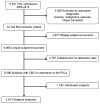RBC Distribution Width: Biomarker for Red Cell Dysfunction and Critical Illness Outcome?
- PMID: 27832023
- PMCID: PMC5291765
- DOI: 10.1097/PCC.0000000000001017
RBC Distribution Width: Biomarker for Red Cell Dysfunction and Critical Illness Outcome?
Abstract
Objectives: RBC distribution width is reported to be an independent predictor of outcome in adults with a variety of conditions. We sought to determine if RBC distribution width is associated with morbidity or mortality in critically ill children.
Design: Retrospective observational study.
Setting: Tertiary PICU.
Patients: All admissions to St. Louis Children's Hospital PICU between January 1, 2005, and December 31, 2012.
Interventions: We collected demographics, laboratory values, hospitalization characteristics, and outcomes. We calculated the relative change in RBC distribution width from admission RBC distribution width to the highest RBC distribution width during the first 7 days of hospitalization. Our primary outcome was ICU mortality or use of extracorporeal membrane oxygenation as a composite. Secondary outcomes were ICU- and ventilator-free days.
Measurements and main results: We identified 3,913 eligible subjects with an estimated mortality (by Pediatric Index of Mortality 2) of 2.94% ± 9.25% and an actual ICU mortality of 2.91%. For the study cohort, admission RBC distribution width was 14.12% ± 1.89% and relative change in RBC distribution width was 2.63% ± 6.23%. On univariate analysis, both admission RBC distribution width and relative change in RBC distribution width correlated with mortality or the use of extracorporeal membrane oxygenation (odds ratio, 1.19 [95% CI, 1.12-1.27] and odds ratio, 1.06 [95% CI, 1.04-1.08], respectively; p < 0.001). After adjusting for confounding variables, including severity of illness, both admission RBC distribution width (odds ratio, 1.13; 95% CI, 1.03-1.24) and relative change in RBC distribution width (odds ratio, 1.04; 95% CI, 1.01-1.07) remained independently associated with ICU mortality or the use of extracorporeal membrane oxygenation. Admission RBC distribution width and relative change in RBC distribution width both weakly correlated with fewer ICU- (r = 0.038) and ventilator-free days (r = 0.05) (p < 0.001).
Conclusions: Independent of illness severity in critically ill children, admission RBC distribution width is associated with ICU mortality and morbidity. These data suggest that RBC distribution width may be a biomarker for RBC injury that is of sufficient magnitude to influence critical illness outcome, possibly via oxygen delivery impairment.
Figures




Comment in
-
RBC Distribution Width: Old Dog, New Trick?Pediatr Crit Care Med. 2017 Feb;18(2):193-194. doi: 10.1097/PCC.0000000000001033. Pediatr Crit Care Med. 2017. PMID: 28157796 No abstract available.
References
-
- Constantino B. Red cell distribution width, revisited. Laboratory Medicine. 2013;44
-
- Felker GM, Allen LA, Pocock SJ, Shaw LK, McMurray JJ, Pfeffer MA, Swedberg K, Wang D, Yusuf S, Michelson EL, Granger CB Investigators C. Red cell distribution width as a novel prognostic marker in heart failure: data from the CHARM Program and the Duke Databank. Journal of the American College of Cardiology. 2007;50:40–47. - PubMed
-
- van Kimmenade RR, Mohammed AA, Uthamalingam S, van der Meer P, Felker GM, Januzzi JL., Jr Red blood cell distribution width and 1-year mortality in acute heart failure. European Journal of Heart Failure. 2010;12:129–136. - PubMed
-
- Lee JH, Chung HJ, Kim K, Jo YH, Rhee JE, Kim YJ, Kang KW. Red cell distribution width as a prognostic marker in patients with community-acquired pneumonia. American Journal of Emergency Medicine. 2013;31:72–79. - PubMed
Publication types
MeSH terms
Substances
Grants and funding
LinkOut - more resources
Full Text Sources
Other Literature Sources
Medical

